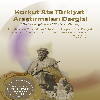Sınıfsız Afsin-Elbistan Uçucu Külü ve Atık Cam Tozundan Yapılan Harçların Özellikleri
PROPERTIES OF MORTARS PRODUCED WITH CLASSLESS AFSIN-ELBISTAN FLY ASH AND WASTE GROUND GLASS
___
- ASTM C1293-08b, 2009, Standard Test Method for Determination of Length Change of Concrete Due to Alkali- Silica Reaction, ASTM Annual Book of Standards, Volume 04.02, Concrete and Aggregates, ASTM International, West Conshohocken, Pennsylvania, USA.
- Atis, C.D., Tartıcı, H., Sevim, U.K., Ozcan, F., Akcaozoglu, K., & Yuzgec, C., 2002, Afsin-Elbistan uçucu külünün beton katkısı olarak kullanılabilirliği, 5. Uluslararası Inşaat Mühendisliğinde Gelişmeler Kongresi, Istanbul, pp. 161-16 (In Turkish).
- Bentli, İ., Uyanık, A.O., Demir, U., Şahbaz, O., & Çelik, M.S., 2005, Seyit Ömer Termik Santrali Uçucu Küllerinin Tuğla Katkı Hammaddesi Olarak Kullanımı, Türkiye 19. Uluslararsı Madencilik Kongresi ve Fuarı. /MCET2005, İzmir, Türkiye, 09-12 Haziran, syf. 385-392(In Turkish).
- Buchwald, A., Kaps, C., & Hohmann, M., 2003, Alkali-activated binders and pozzolan cement binderscompete binder reaction or two sides of the same story? In: Proceedings of the 11th international congress on the chemistry of cement (ICCC), Durban, p. 1238–46.
- Binici, H., & Aksogan, O., 2006, Sulfate resistance of plain and blended cement, Cement and Concrete Composite 28 39-46.
- Federico, L.M., Chidiac, & S.E., 2009, Waste glass as a supplementary cementitious material in concrete – Critical review of treatment methods, Cement & Concrete Composites 31 606–610
- Ghazali, M., Kausha, O. P., 2015, Characteristics of Fly Ash from Thermal Power Plants and its Management along with Settling Pond Design, International Journal of Engineering Research & Science, vol.1, pp.24-32.
- Kaplan, H., & Binici, H., 1996, Trass and trass cement. Cem World 1:23–30
- Kılınckale, M. F., 1995, Uçucu Küllü Çimento Üretiminde Uçucu Külün Öğütme Şeklinin Çimento Üzerinde Etkisi, Endüstriyel Atıkların İnşaat Sektöründe Kullanılması Bildiriler Kitabı, TMMOB yayını, 172 s, Ankara, (In Turkish).
- Kockal, N.U., & Ozturan, T., 2010, Effects of lightweight fly ash aggregate properties on the behavior of lightweight concretes, Journal of Hazardous Materials, vol. 179, pp. 954–965.
- Massazza, F., 1993, Pozzolanic cements, Cement and Concrete Composites 15 185-214
- Mukhopadhyay, K. A., & Liu, W. K., 2015, Application of nanotechnology to control ASR in Portland cement concrete, Nanotechnol. Constr. 465–471.
- Omran, A., & Tagnit-Hamou. A., 2016, Performance of glass-powder concrete in feld applications, Construction and Building Material 109 84-95.
- Park, B. S., Lee, C. B., & Kim, H. J., 2004, Studies on Mechanical Properties of Concrete Containing Waste Glass Aggregate, Cement and Concrete Research 34(12) (2004) 2181-2189.
- Sevim, U.K., 2003, Afşin-Elbistan Uçucu Külünün Beton ve Çimento Hamuru ve Harçlarının Üzerinde Yapılan Deneylerle Araştırılması, Doktora Tez Projesi, Proje No: FBE 2002 D 179, (In Turkish).
- Shao, Y., Lefort, T., Moras, S., & Rodriguez, D., 2000, Studies on concrete containing ground waste glass, Cement and Concrete Research 30 91-100.
- Shi, C., Wu, Y., Riefer, C., & Wang, H., 2005, Characteristics and Pozzolanic Reactivity of Glass Powders, Cement and Concrete Research 35 987-993.
- Tokyay, M., 1994, What is trass cement? What is not? TMMOB Chamber of Civil Engineers, 12-15 December, Ankara
- Topcu, I.B., & Canbaz M., 2004, “Properties of concrete containing waste glass”. Cement Concrete Research, 34(1), 267–74,
- Turgut, P., 2007, “The use of limestone and glass powder in briquette production 7. National Concrete Congress, Istanbul, Turkey, 29 November-1 December
- Turgut, P., 2018, Block Production Using Fly Ash, Lime and Glass Powder, Pamukkale University Journal of Engineering Sciences 24 (3) 413-418.
- Turku, P., Erdogan, B., Katnas, F., & Yeğinobalı A., 2009, Classıfıcatıon In Turkey Propertıes Of Fly Ash, Cbt, Ankara
- Turkmenoglu, A., Tankut, A., Tokyay, M., & Turan C., 2000, Pozzolanic activities of natural additives from Ankara Region Turkey. Istanbul, Turkey, vol. 11, September p. 304–13.
- TS EN 196-3 2002, Cement Test Methods - Part.3: Setting time and expansion determination, Turkish Standards Institute, Ankara
- TS EN 450-1 2015, Fly Ash-Used in Concrete-Part 1: Definition, Properties and Compliance Criteria, Turkish Standards Institute, March, Ankara
- Zeidan, M., & Said, M. A., 2016, Effect of colloidal nano-silica on alkali–silica mitigation, J. Sustainable Cem. -Based Mater. 6 (2) 126–138.
- Yayın Aralığı: Yılda 4 Sayı
- Yayıncı: Konya Teknik Üniversitesi, Mühendislik ve Doğa Bilimleri Fakültesi
HAVA LİDARI VERİLERİNE UYGULANAN FARKLI ENTERPOLASYON YÖNTEMLERİNİN SAM DOĞRULUĞUNA ETKİSİ
Duygu ARIKAN, Ferruh YILDIZ, Hasan Bilgehan MAKİNECİ
DERİN SİNİR AĞLARI VE YENİDEN ÖRNEKLEME METOTLARI İLE RUTİN KAN TESTLERİNE DAYALI COVID-19 TESPİTİ
Mahmut TOKMAK, Ecir Uğur KÜÇÜKSİLLE
Bütünleştirici Analiz Kullanarak Behçet Hastalığında Biyobelirteç Adayları Belirlenmesi
Ezgi AKCEYLAN, Begüm TABAKCI, Serkan ERDEMİR, Egemen ÖZÇELİK
BETONARME SONLU ELEMAN ANALİZİNDE ALTERNATİF BİR KOHEZİF ÇATLAK MODELİ
Farklı duvar örgüleri ile üretilmiş prototip yığma binaların sarsma tablası deneyleri
Fatih BAHADIR, Fatih Süleyman BALIK
Mahmud Sami DÖNDÜREN, Şeyda HAVA, Ali Serdar ECEMİŞ
MADEN İŞLETMELERİNDE COVID 19 SALGININA KARŞI MÜCADELE VE ALINACAK TEDBİRLER
GÜNEŞ ENERJİSİ KOLEKTÖRÜ ÜRETİMİNDE KAYNAK BAĞIMLI GÖREV SÜRELERİ İLE PARALEL MONTAJ HATTI DENGELEME
